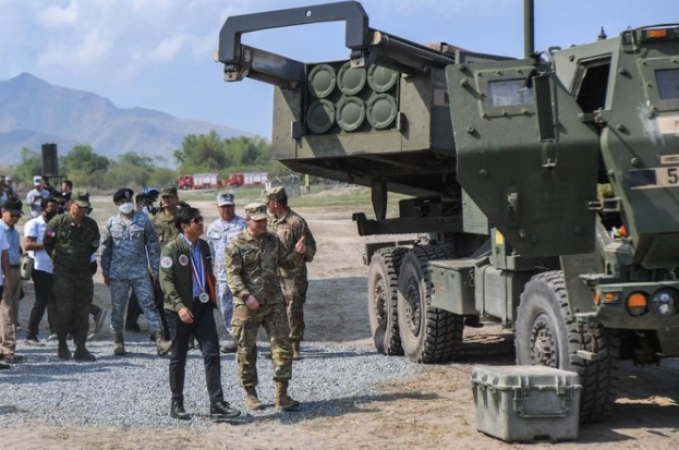
Philippines: In their largest war drills to date, American and Filipino forces, numbering in the thousands, bombarded a ship with high-precision rockets, airstrikes, and artillery fire on Wednesday in Philippine waters bordering the disputed South China Sea, likely infuriating China.
The latest example of President Ferdinand Marcos Jr.'s steadfast support for the Philippines' treaty alliance with the US was his observation of the American display of firepower from an observation tower in the coastal town of San Antonio in northwest Zambales province.
As China's actions in the South China Sea become a top concern, Marcos has ordered his military to focus on external defence rather than the long-running anti-insurgency conflicts. The Biden administration's goal of strengthening an Indo-Pacific alliance arc to better counter China is aligned with the shift in the Philippine defence strategy.
Also Read: The Girls, Women, and Society Chair is established by ICESCO at Omar Bongo University in Gabon
By repeatedly harassing its navy and coast guard patrols and chasing away fishermen in the waters close to Philippine shores but which Beijing claims as its own, China has enraged the Philippines. Since last year, the Philippines has lodged more than 200 diplomatic protests against China, at least 77 of which were done so since the June election of President Marcos.
Marcos watched through a pair of binoculars as rockets streaked into the sky from the US High Mobility Artillery Rocket System, or HIMARS, a multiple rocket and missile launcher mounted on a truck that has become a vital weapon for Ukrainian troops battling Russian invasion forces, while sitting next to US Ambassador MaryKay Carlson and his top defence and security advisers.
Ahead of Marcos, a coastal clearing resembled a war zone shrouded in smoke, rumbling under the artillery fire of AH-64 Apache attack helicopters.
The Armed Forces of the Philippines and the US military prioritised increasing the exercise's complexity and realism, according to Lt. Gen. William Jurney, commander of US Marine Corps Forces, Pacific.
The annual joint drills are known as Balikatan, which is Tagalog for "shoulder-to-shoulder." According to Jurney, the US director, "Together we are strengthening our capabilities in full-spectrum military operations across all domains."
Also Read: 'Let's finish this job,' says Biden in announcing his bid for reelection in 2024
The largest exercises since Balikatan began three decades ago included 12,200 US military personnel, 5,400 Filipino forces, and 111 Australian counterparts. According to US and Philippine military officials, the exercises featured US warships, fighter jets, Patriot missiles, HIMARS, and anti-tank Javelins.
A decommissioned Philippine navy warship that had been towed about 18 to 22 kilometres out to sea was the vessel that the allies' forces had targeted.
In order to simulate a battle scene where dispersed allied forces could identify and locate enemy targets and then launch precise rocket and missile fire, smaller floating targets, such as empty drums tied together, were also used as targets.
The exercises, according to Philippine military officials, would improve the nation's capacity for coastal defence and disaster response and were not directed at any specific nation. China has previously objected to US military exercises in the area as well as an increase in US military deployments, which it warned would ratchet up tensions and undermine regional peace and stability.
Washington and Beijing have been at odds over China's escalating territorial defence actions in the South China Sea and Beijing's ambition to annex Taiwan, using force if necessary.
In February, Marcos gave his approval for a larger US military presence in the Philippines by allowing American troops to station themselves in four additional Philippine military camps in batches. That represented a sharp departure from the position of his predecessor Rodrigo Duterte, who was concerned that a stronger American military presence might enrage Beijing.
China vehemently opposed the plan, which would have allowed US forces to set up staging areas and surveillance stations in the western and northern Philippine provinces facing the South China Sea and across the water from Taiwan. Beijing claims these areas practically in its entirety.
Also Read: Despite Rana Plaza Bangladeshi garment workers continue to fight
China has issued a warning that a growing security alliance between Washington and Manila, as well as their ongoing military exercises, should not endanger its security and territorial interests or get in the way of the ongoing territorial disputes.
Such military cooperation, according to the Chinese Foreign Ministry, "should not target any third party and should be conducive to regional peace and stability."